-
Car Reviews
- All reviews
- Midsize SUVs
- Small cars
- Utes
- Small SUVs
- Large SUVs
- Large cars
- Sports SUVs
- Sports cars
- Vans
Latest reviews
- Car News
-
Car Comparisons
Latest comparisons
- Chasing Deals
Hyundai’s Elantra replacement finally gets an engine good enough to unlock the talents of the excellent chassis beneath.
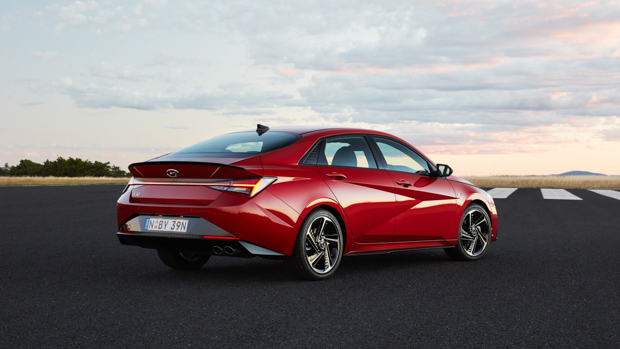
Hyundai’s 2021 i30 line-up is more complete than ever with the arrival of the sedan in N Line trim, which arrives in Australia this month in $30,290 manual, $32,290 automatic and top-shelf, auto-only $37,290 Premium trim.
Hyundai bullishly say the i30 N Line Sedan is a car good enough to get the public to reconsider their love of SUVs – but is it all that?
The new model is on sale now and complements the current i30 Sedan Active and Elite by offering a bit more pep and sportiness – just as in the hatch range. For those unfamiliar with the i30 sedan moniker, it replaces the Elantra in the Australian market.
Underpinning the i30 sedan is an all-new platform, so the four-door is almost a completely different car. Despite measuring in at 4,675mm – that’s 300mm longer than the hatch with an extra 100mm of wheelbase – the sedan with an automatic gearbox is lighter to the tune of 4kg.
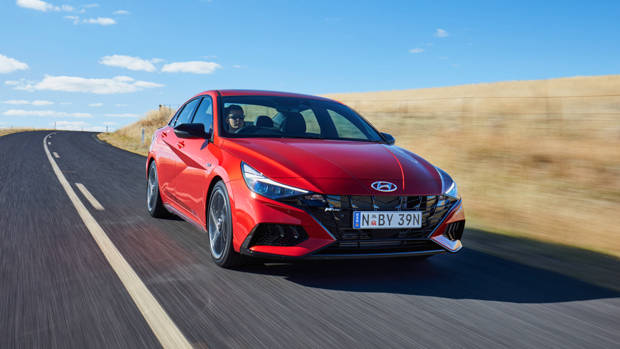
While the total weight loss may be somewhere in the order of one big bowl of bibimbap, that statistic is just the start of the differences between the four and five-door car.
Hyundai’s latest design language is bold and divisive, but that’s better than blobby and boring in our eyes. The rear three-quarter is where the i30 Sedan is most attractive, with a full-width LED signature surreptitiously illuminating to form the letter ‘H’.
The sharp boot deck gets an aggressive lip spoiler, and the extra gloss black plastic lends the N Line a little more athletic flair overall.
There are some elements of the Bangle BMW era in the styling with unconventional surfacing down the flanks. Busy is the word some will choose, but the car looks better in N Line guise regardless of your view. Truth be told, we quite like the appearance.
Almost immediately, you notice the difference between this i30 sedan and the more familiar hatchback. From the moment you trundle over chopped up urban tarmac, the four-door feels lighter on its feet. The N Line takes this and makes the sedan even better with almost no comfort trade-off.
While that is helped by the extensive Australian ride and handling program at Hyundai, the newer ‘K6’ platform underpinning the sedan makes the most difference.
Hyundai Australia tweaked the dampers, springs, and sway bars for the N Line sedan. As in the hatch, the N Line sedan benefits from an independent rear suspension set-up that addresses the regular car’s noisy torsion beam back end.
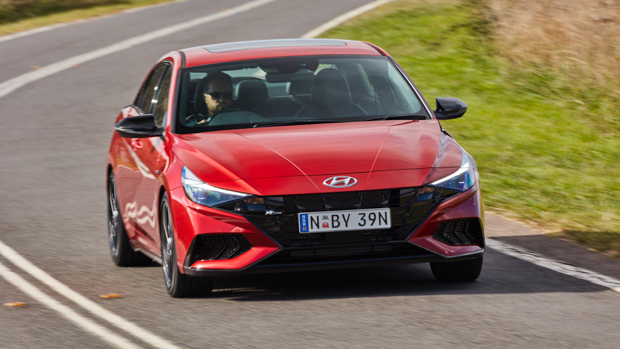
Unlike the hatch where the N Line is appreciably firmer, the difference between the regular i30 Sedan and the N Line in ride quality is almost negligible in urban environments, with the N Line displaying much better control at speed.
Where the hatch preferences understeer toward the limit, the i30 sedan in N Line trim offers more adjustability. The talented four-door is happy to dance its way through a tightening radius bend and makes the hatch feel somewhat flat-footed.
Outright grip is not monstrous on the Goodyear Eagle F1 tyres, but the N Line is pliable and genuinely fun to drive, besting any similarly-priced SUV in our books. This bodes well for the forthcoming N Performance version of the sedan.
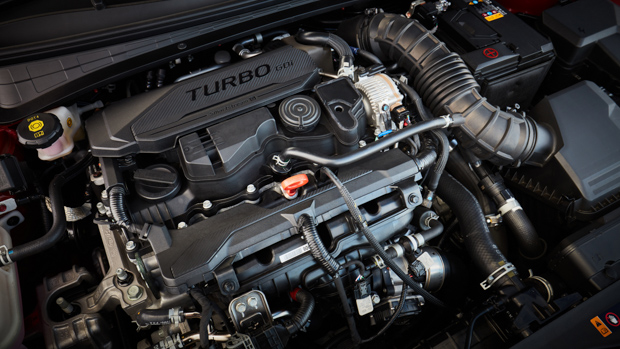
While most of this praise stands for the regular i30 sedan, the new 1.6-litre turbocharged ‘Smartstream G’ four-cylinder engine allows the keen driver to unlock the sedan’s back-road performance. The car feels harmonious with an adequate amount of grunt – 150kW of power and 265Nm of torque, to be exact – without ever overpowering the i30.
You may be confused about the ‘new’ claim of the engine; after all, it has the same displacement and outputs as found in the hatch, but the sedan has new ‘CVVD’ variable valve duration technology and turbo. The changes make for a more tractable powerband with less unpleasant boostiness of the old engine.
Yes, the Hyundai i30 sedan may be a low volume vehicle for the marque, but they still offer a manual gearbox option for Australians, with around 7 per cent of buyers expected to tick the option. It’s a slick enough six-speed with light throws, though it’s not the star of the show that the i30 N’s muscular gearbox is.
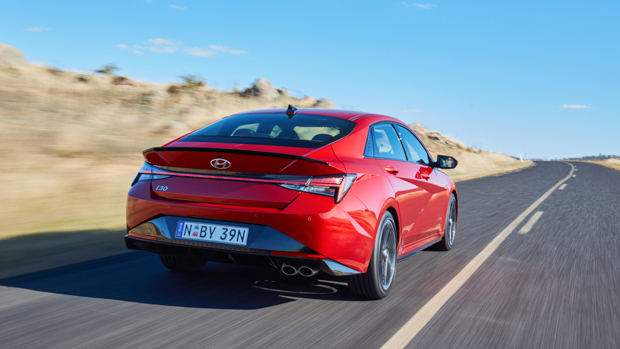
The majority of buyers will go for the seven-speed dual-clutch gearbox, which also benefits from selectable drive modes. The dry-clutch gearbox is mechanically unchanged from the hatch, but the programming has been updated. It stays out of the way most of the time and downshifts when you need it in sport mode.
For the most part, the ‘smart’ mode was the pick, keeping the i30 a little more awake to sudden throttle inputs and kicking down more smartly than when left in normal all with natural steering weight. Sport added meaningful weight t0 the steering and welcomed sharp throttle response for driving with more vigour.
The base N Line is equipped with adaptive cruise control, AEB with pedestrian, cyclist and junction functionality, lane-follow assist and blind-spot monitoring. Jumping up to the Premium we tested adds valuable rear cross-traffic alert and reverse AEB functionality.
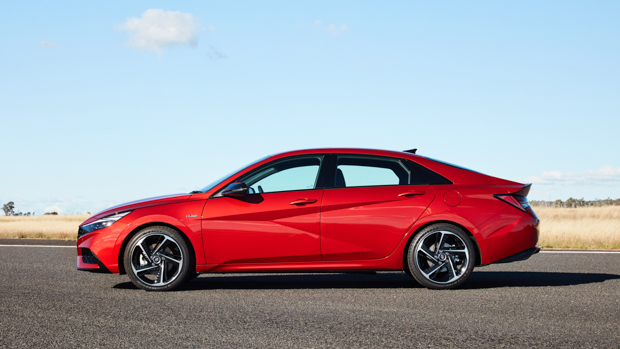
Hyundai has ticked almost all the active safety boxes to guarantee a five-star ANCAP rating. Still, as the testing protocol becomes more stringent, the lack of a centre airbag leaves the i30 sedan a safety-rating orphan.
That lack of rating may be enough to exclude the sedan from some people’s purchase lists, which is a shame because the active safety suite feels more polished than many of this car’s competitors.
Hyundai has built some almost art deco details inside the cabin, which is virtually nothing like that of the hatch. The three-spoke N Line steering wheel returns with red-stitching as a sporty point-of-difference to the regular sedan’s four-spoke item. Black is sadly the only upholstery colour choice, with cream leather offered only on the Elite.
The gear looks swanky, but the touch-points highlight that money was sunk into design instead of the materials. The door tops and the dashboard are covered in cheap-feeling plastic, while the attractive grab-handle that separates the driver from the passenger feels a little creaky underhand.
In reality, those are small complaints, because the sedan is otherwise well screwed together, and we did not notice any creaks in the cabin on gnarly coarse-chip surfaces.
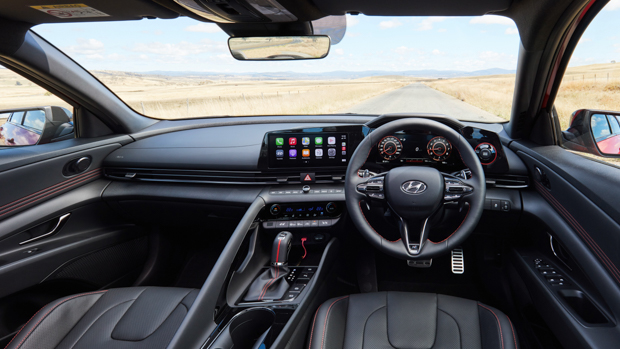
Our N Line Premium had dual 10.25-inch screens – the central touchscreen handles the infotainment with navigation, DAB and wired Apple CarPlay and Android Auto, while the other functions as a digital driver’s display.
However, the inability to display a map in the digital driver’s display is a bit of a let-down. The $30,290 ‘normal’ N Line’s analogue gauges do nearly as good a job in reality.
The regular N Line benefits from wireless Apple CarPlay and Android Auto on its smaller eight-inch infotainment system due to some quirks in Hyundai’s spec. The N Line also brings comfortable suede-cloth and leatherette-appointed seats with manual adjustment.
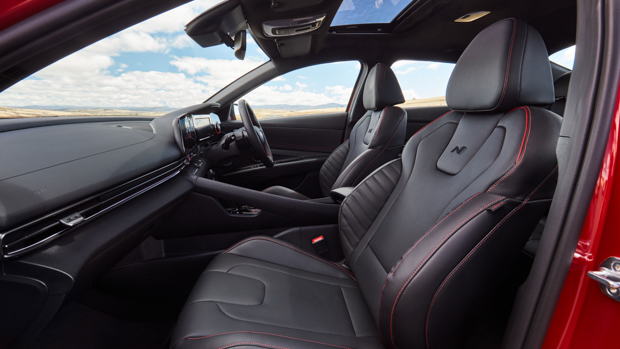
For its $37,290 list price our N Line Premium was equipped with ten-way power adjustable, heated, coolied and leather-appointed seats. The Premium’s leather will definitely be easier to clean, but the grippier suedecloth of the regular car holds the driver in slightly better. Regardless, the N Line’s seats are a comfy place to be.
Hyundai has transitioned to Bose for their premium sound system which features in the N Line premium and the quality is good, if not outstanding.
The rear quarters offer plenty of knee and toe room even at six-foot-two, and headroom will be plentiful for anyone less than six-foot. Niceties like adjustable air vents, two Isofix ports and a flip-down armrest are found in the back, and at a pinch, three could squeeze across the bench.
Carrying capacity is up nearly 20 per cent compared to the hatch, with space for 474L of cargo. Though, the N Line’s sophisticated multi-link suspension means that only a space-saver spare is on board – still, better than nothing.
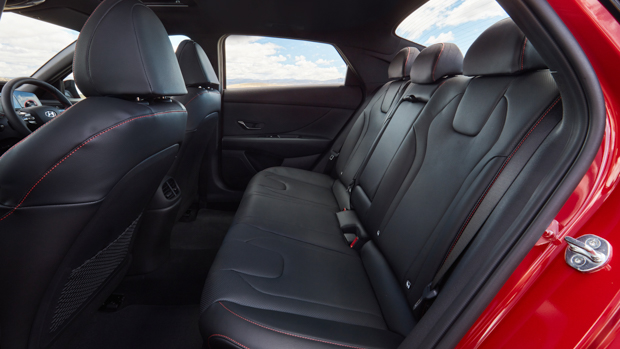
The new 1.6-litre engine may be no more potent than before, but fuel efficiency was the main aim in development, according to Hyundai.
Our test loop saw the DCT car return 7.6L/100km, a little shy of the claimed 6.8L/100km score but respectable given the terrain.
The more relaxed highway cruise home that consumption fell to an impressive 6.7L/100km – better than we returned in the two-litre i30 Sedan.
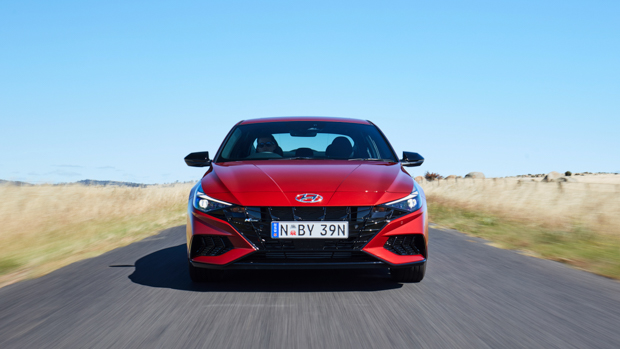
Hyundai backs the i30 sedan N Line with the industry-standard five-year/unlimited-kilometre warranty, though the Kia Cerato sedan offers a lengthier seven-year guarantee.
Servicing needs to be carried out every 12 months or 10,000kms for the 1.6-litre turbocharged cars, with the price capped at $299 each visit. That equates to a total of $1,495 over a five year ownership period.
Finally, Hyundai has put an engine in the front of the i30 sedan that unlocks the chassis’s potential. The new model feels harmonious, offering more talent and driver enjoyment without sacrificing crucial ride comfort.
It’s better than the hatch to drive and be inside, but it’s up to you to decide whether the sedan is a better looker – though we think so. There are a few bugbears, namely the lack of centre airbag and therefore safety rating, cheap cabin materials and digital gauges that are simply an imitation of analogue items.
However, on the whole, the i30 sedan N Line car is a success. The new N Line sedan looks, handles, rides and goes better than the regular car, making it the pick of the i30 range even for those not looking for a performance car.
Variant tested N Line manual
Key specs (as tested)
About Chasing cars
Chasing Cars reviews are 100% independent.
Because we are powered by Budget Direct Insurance, we don’t receive advertising or sales revenue from car manufacturers.
We’re truly independent – giving you Australia’s best car reviews.
The estimate provided does not take into account your personal circumstances but is intended to give a general indication of the cost of insurance, in order to obtain a complete quote, please visit www.budgetdirect.com.au. Estimate includes 15%^ online discount.
^Conditions Apply
Budget Direct Insurance arranged by Auto & General Services Pty Ltd ACN 003 617 909(AGS) AFSL 241 411, for and on behalf of the insurer, Auto & General Insurance Company Limited(ABN 42 111 586 353, AFSL 285 571).Because we don’t know your financial needs, we can’t advise you if this insurance will suit you. You should consider your needs and the Product Disclosure Statement before making a decision to buy insurance. Terms and conditions apply.
Indicative quote based on assumptions including postcode , 40 year old male with no offences, licence suspensions or claims in the last 5 years, a NCD Rating 1 and no younger drivers listed. White car, driven up to 10,000kms a year, unfinanced, with no modifications, factory options and/or non-standard accessories, private use only and garaged at night.
^Online Discounts Terms & Conditions
1. Discounts apply to the premium paid for a new Budget Direct Gold Comprehensive Car Insurance, Third Party Property Only or Third Party Property, Fire & Theft Insurance policy initiated online on or after 29 March 2017. Discounts do not apply to optional Roadside Assistance.
2. Discounts do not apply to any renewal offer of insurance.
3. Discounts only apply to the insurance portion of the premium. Discounts are applied before government charges, taxes, levies and fees, including instalment processing fees (as applicable). The full extent of discounts may therefore be impacted.
4. We reserve the right to change the offer without notice.